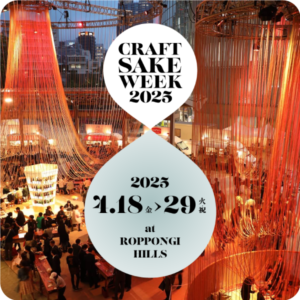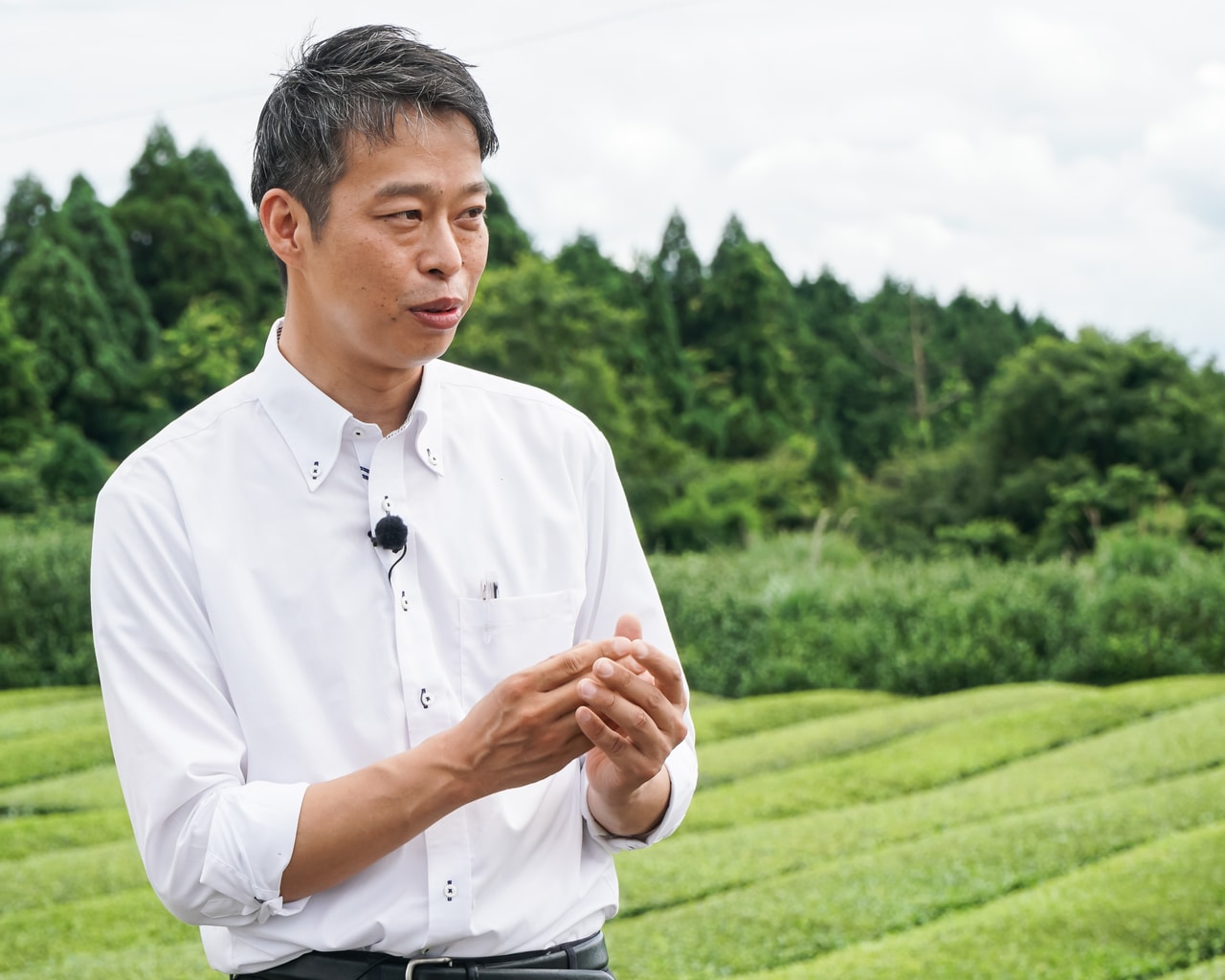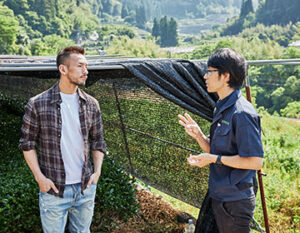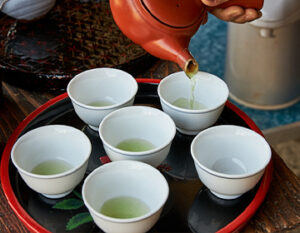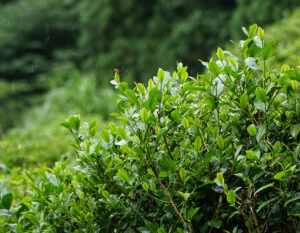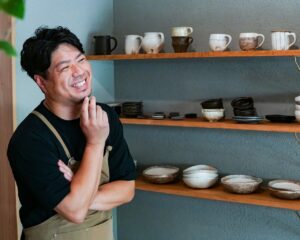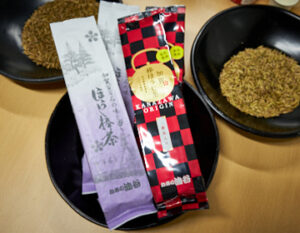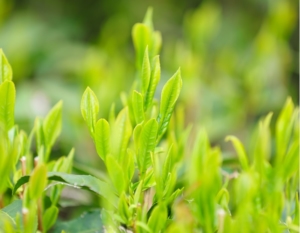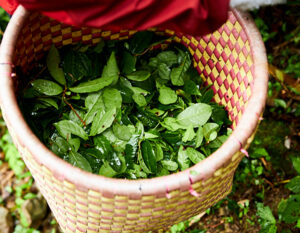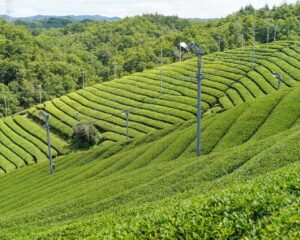Tsuchiyama in Koka City, Shiga Prefecture, is famous for its excellent tea production.
Omicha Marukichi is a long-established tea merchant that has been in this area for over 100 years.
As a specialist in hojicha (roasted green tea), the store offers a wide variety of hojicha and related products.
You are sure to find a supreme cup of tea made from carefully selected raw materials and advanced techniques by tea professionals including “Chashi-Judan” (tea master).
Over the past few years, hojicha has been steadily gaining popularity. The style of “hojicha latte” has also become widespread. One person who was quick to recognize the appeal of hojicha is Kenji Yoshinaga, representative of “Omicha Maruyoshi,” a roasted tea specialty store in the town of Tsuchiyama, one of Shiga Prefecture’s major tea-producing regions.
Roasted tea specialty store” established in Tsuchiyama, the largest tea producing area in Shiga Prefecture
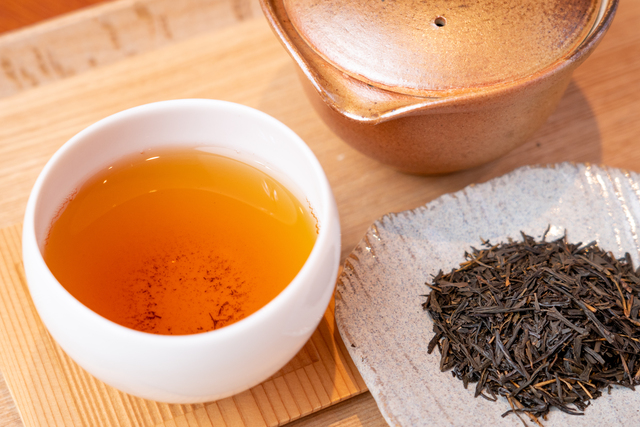
Tsuchiyama is a town at the foot of the Suzuka Mountains, which separates Shiga and Mie prefectures. The town boasts the largest area and production of tea in Shiga Prefecture, with temperatures ranging from 35°C in the summer to -5°C in the winter, making it ideal for tea cultivation. However, Shiga Prefecture ranks 13th in the nation in terms of tea production (in 2020), and is not well known as a tea-producing region. The number of tea farmers, which once numbered about 300, is now down to about 100.
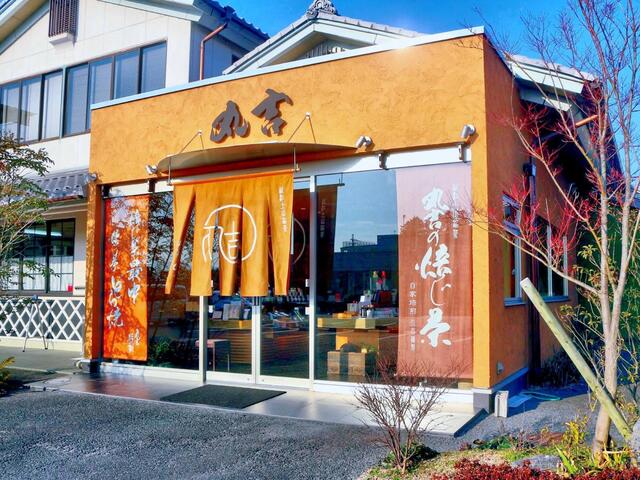
Who is the driving force behind the “hojicha specialty store?
Mr. Kenji Yoshinaga of ” Omicha Maruyoshi, ” a roasted tea specialty store, is striving to raise the profile of Shiga Prefecture-grown tea by offering high quality tea in a way that other stores do not. Mr. Yoshinaga is the seventh generation of Maruyoshi Omi Cha, a tea wholesaler with over 100 years of history in Tsuchiyama-cho. He is also one of only 15 people in Japan to hold the title of ” tea master 10th dan. He is a professional who takes rough tea leaves, which are processed by tea farmers, and turns them into products by sifting, blending (called gougumi ), and heating the tea leaves.
What is a “tea master 10-dan”?
I would like to explain a little more about Mr. Yoshinaga’s title, “Chashi-Judan.
Chashi-Judan is the highest rank in tea judging and appraisal skills, and is awarded at the National Tea Judging Techniques Competition held once a year by the National Federation of Tea Industry Youth Organizations. It is said to be an extremely difficult task in the tea industry, and only 15 people have been certified in the 70 years since the competition was first held. The store’s hojicha tea is a perfect example of this skill of connoisseurship.
A bittersweet experience overseas made him realize the potential of hojicha.
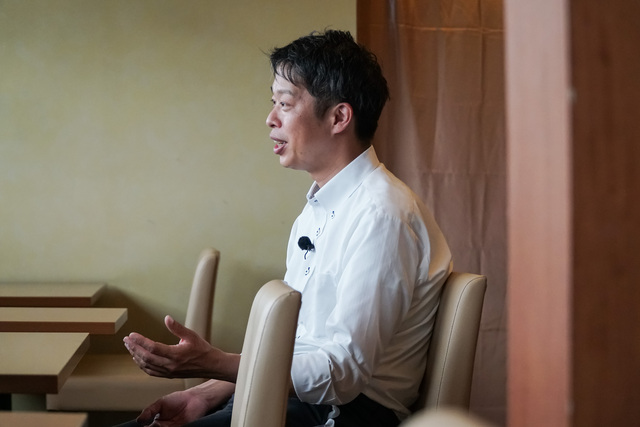
Although there was a desire to market the tea produced by the company as “Shiga tea,” consumption of green tea was on the decline when Mr. Yoshinaga entered the business around the year 2000. Mr. Yoshinaga began to go on overseas sales trips in order to find new sales channels.
He eventually traveled to the U.S., Singapore, China, and other foreign countries to attend exhibitions, but he did not get the desired response wherever he went. Buyers who tasted his sencha tea responded negatively, saying it was “tasteless,” “salty,” “bitter,” and “astringent. Then, Mr. Yoshinaga realized something.
The hojicha I brought along was better received for its savory and delicious taste.”
The response from the younger generation in Japan was also similar. Young people tend to dislike bitterness and prefer tea with a strong aroma. Feeling this way, Mr. Yoshinaga decided to specialize in hojicha.
Throughout Maruyoshi’s history, the company has developed its business in line with current trends. Fortunately, he had accumulated expertise in roasting techniques by taking on requests from other manufacturers, and he was not anxious about steering the company toward hojicha, a tea with an emphasis on aroma. In fact, I even felt a sense of mission to make the switch.
I could see the way forward.
I think the teas here in Tsuchiyama are suited for hojicha,” he said. Because of the extreme temperature differences in the mountains, it takes longer for the tea leaves to grow, but this makes it possible to produce a heavy tea with a strong flavor and aroma. The richness of tea tends to weaken when it is heated, but Tsuchiyama tea leaves retain their flavor even after being heated,” says Yoshinaga.
His experience as a tea wholesaler handling a wide range of sencha and hojicha teas was also helpful in opening a store specializing in hojicha. However, from now on, he will shift his focus from “I can do everything” to ” I will do only hojicha. When he made this decision, the path he should take became clear, Yoshinaga said.
The roasted tea specialty store Omi Cha Marukichi, which opened in 2014, carries a variety of packaged products, and it is surprising to see how many different variations of hojicha alone can be enjoyed. The shop also offers ” molasses hojicha,” which is made by powdering high-quality Japanese tea leaves into a hojicha powder using a proprietary process and adding honey.
More than 100 different prototypes, “wide variety” is the appeal of hojicha.
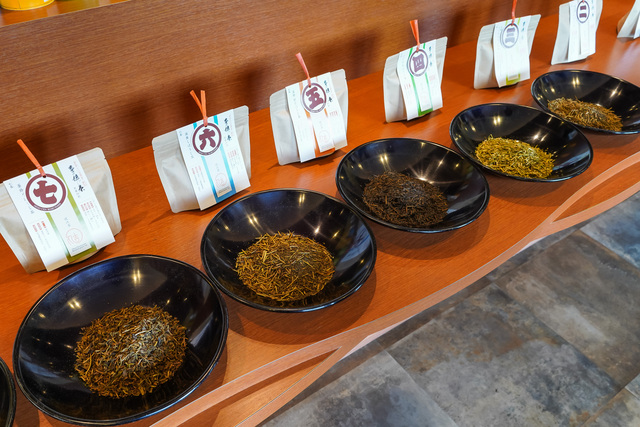
Mr. Yoshinaga created the 10 types of hojicha teas that have become a staple in the company’s lineup after more than 100 different prototypes. It is surprising how different they look even when the tea leaves are arranged side by side.
For example, the first “Highest-grade Tsuchiyama Hojicha” is made by selecting only the first tea sprouts and roasting them slowly at a low temperature. The green tea leaves are not recognizable as hojicha at first glance, but when you put your nose close to them, you can smell the slight aroma of roasting. When you drink it, the aroma is clear to the nose and leaves a mild umami taste on the palate.
On the other hand, the most popular No. 5, “Meimono Tongu Hojicha,” is a deep-roasted, direct flame-roasted, orange-black tea leaf. It is popular among serious tea lovers who seek a full-bodied flavor, and the fragrant aroma at the top suggests its hojicha-like qualities.
As you can see, it is interesting to note the different personalities of hojicha in a single word. It is likely that everyone will find a flavor to their liking.
Roasting allows the brewer to freely control the aroma and taste.
By the way, how does one come up with variations in the flavor of hojicha? Rather than differences depending on the variety of tea, it is a combination of the parts used (leaves, stems, etc.), the time of year the tea leaves are picked, the way the tea leaves are plucked, and the roasting temperature and time.
For example, even if the same tea leaves are used, roasting at a low temperature will give a heavy flavor, while roasting at a high temperature will produce a tea with a lighter taste and more aroma at the beginning of drinking.
Another unique characteristic of hojicha is that the aroma of the leaf veins of the tea leaves can be captured. When roasted, the veins of the leaves swell and release their aroma. The veins of first-grade tea leaves are softer, which gives it a sweeter aroma when roasted. With a thorough understanding of these characteristics, the brewers experiment with various combinations of teas in pursuit of the best taste.
Health benefits such as reduced caffeine
In addition to increasing the aroma, roasting also brings health benefits. It is said that roasting reduces the amount of caffeine and increases the amount of pyrazine in the tea, thereby promoting blood circulation.
Some people may have an image of hojicha as “cheaper than sencha” or “made from old tea leaves that have been roasted,” but the hojicha made from carefully selected tea leaves offered by Omicha Marukichi is made with the extra step of “roasting. Mr. Yoshinaga is proud of the product. The roasting technique, which brings out the flavor of the tea leaves many times over, is the added value.
The challenge of the entire production area. New aromatic hojicha” from Tsuchiyama
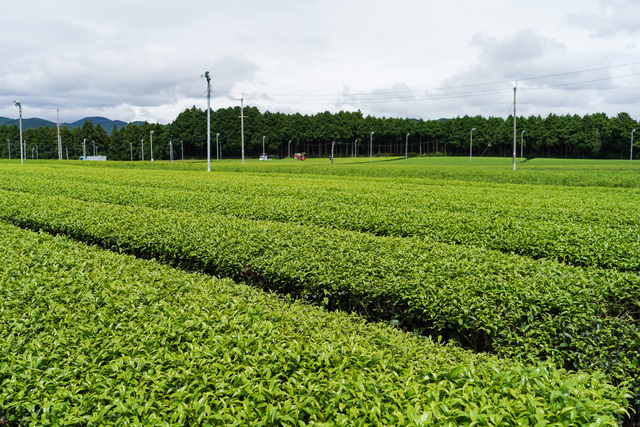
For the past four years, Mr. Yoshinaga has been promoting a project to create a “production area brand” in cooperation with tea farmers, tea wholesalers, and agricultural cooperatives in Tsuchiyama.
In September 2022, he debuted a new brand, “Tsuchiyama Hitoban Hoji.
The key to the aroma of “Tsuchiyama Overnight Hoji” is “wilting.
The key to the aroma of “Tsuchiyama Hitoban Hoji” is the use of wilted tea leaves. Wilting is a process in which harvested tea leaves are left in a well-ventilated place without being immediately heated, allowing them to wilt and develop a gorgeous ” hanaka” (flowery fragrance). The tea leaves produce enzymes to protect themselves and release aromatic compounds during the oxidation process. Oolong tea,popular in Taiwan, is also made using this method.
Roasting wilted tea leaves to make hojicha is another unique challenge and the heart of this project. The combination of the fragrance of the wilted tea leaves and the aroma of the roasted tea leaves is an unprecedented hojicha from Tsuchiyama. This project was made possible by Mr. Yoshinaga, who specializes in hojicha production and has the connoisseurship of a 10th dan tea master.
The “Tsuchiyama Overnight Hojicha” has established the following standards: ” use tea leavesproduced in Tsuchiyama,” ” use aromatic tea leaves that have been wilted for at least 12 hours,” and ” roast by tea masters in Shiga Prefecture and producers in Tsuchiyama. From now on, each producer and tea wholesaler in Tsuchiyama will create their own unique “Tsuchiyama Overnight Hoji” under these standards.
The strength of individuality unique to small-scale production will be utilized. Taking a Strike with the Pride of a Tea Producing Area
As mentioned at the beginning of this article, Tsuchiyama is Shiga’s largest tea production area, but the number of tea farmers has declined to about one-third of what it was at its peak.
However, there are still many small-scale tea farmers in Tsuchiyama who have their own unique characteristics. The small size of the tea farms allows them to take the time and effort to wilt the tea and spend the time to produce “Tsuchiyama Overnight Hoji,” and the tea wholesalers are also engaged in friendly competition to create a roasting method that brings out the individuality of each tea farmer. The tea wholesalers are also engaged in friendly competition to create a roasting method that brings out the best of each tea farmer’s individuality.
We are trying to ferment wilted tea leaves, but fermentation is too deep. The possibilities are endless, depending on the climate, humidity, variety, and other factors. Just because we succeeded today, it doesn’t mean we will succeed tomorrow.
Even so, Mr. Yoshinaga seems to be enjoying himself. In this year’s “Tsuchiyama Overnight Hoji,” Yoshinaga is competing with hojicha, not as a single store, but as a tea-producing region. We cannot take our eyes off of the challenge that tea master Kenji Yoshinaga is taking on the world stage with his pride in the possibilities of hojicha. We hope you will taste the hojicha that the Koka region will send out to the world as a whole.
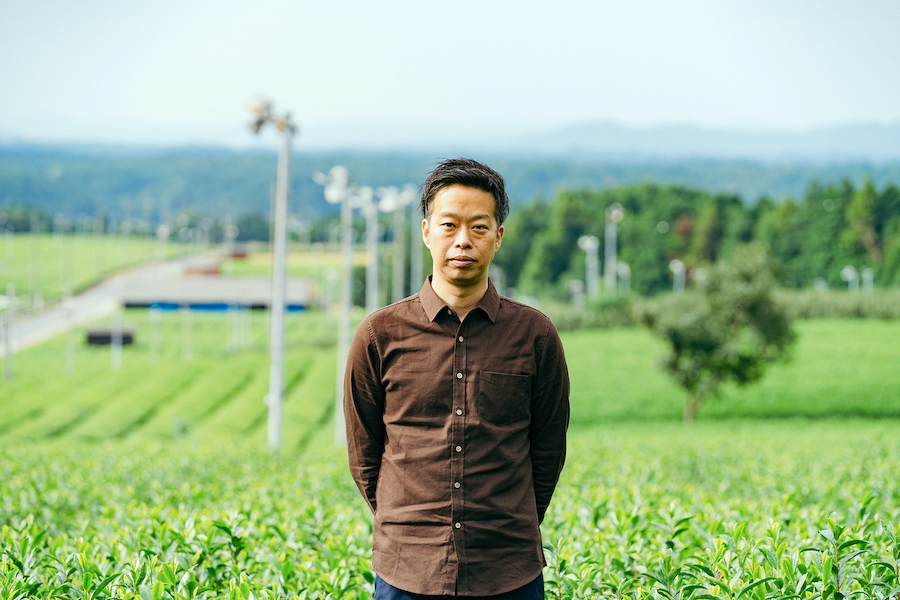
With the diversification of eating habits in recent years, the way we enjoy tea has changed dramatically. While responding flexibly to these changes, we will redouble our efforts to provide enjoyment and healing through tea by “brewing,” “drinking,” and “learning about tea. We invite you to experience the fragrant and flavorful world of Omi tea.


